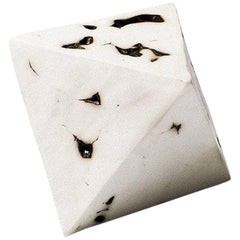Relic Octahedron
Recent Sales
21st Century and Contemporary American Modern Abstract Sculptures
Porcelain
A Close Look at modern Furniture
The late 19th and early 20th centuries saw sweeping social change and major scientific advances — both of which contributed to a new aesthetic: modernism. Rejecting the rigidity of Victorian artistic conventions, modernists sought a new means of expression. References to the natural world and ornate classical embellishments gave way to the sleek simplicity of the Machine Age. Architect Philip Johnson characterized the hallmarks of modernism as “machine-like simplicity, smoothness or surface [and] avoidance of ornament.”
Early practitioners of modernist design include the De Stijl (“The Style”) group, founded in the Netherlands in 1917, and the Bauhaus School, founded two years later in Germany.
Followers of both groups produced sleek, spare designs — many of which became icons of daily life in the 20th century. The modernists rejected both natural and historical references and relied primarily on industrial materials such as metal, glass, plywood, and, later, plastics. While Bauhaus principals Marcel Breuer and Ludwig Mies van der Rohe created furniture from mass-produced, chrome-plated steel, American visionaries like Charles and Ray Eames worked in materials as novel as molded plywood and fiberglass. Today, Breuer’s Wassily chair, Mies van der Rohe’s Barcelona chair — crafted with his romantic partner, designer Lilly Reich — and the Eames lounge chair are emblems of progressive design and vintage originals are prized cornerstones of collections.
It’s difficult to overstate the influence that modernism continues to wield over designers and architects — and equally difficult to overstate how revolutionary it was when it first appeared a century ago. But because modernist furniture designs are so simple, they can blend in seamlessly with just about any type of décor. Don’t overlook them.
Finding the Right paperweights for You
While any heavy object can be used to hold loose papers, there’s nothing as ornate yet perfectly functional as a paperweight. Antique, new and vintage paperweights can unobtrusively enhance the ambience of a room or act as a colorful conversation starter. On a desk or writing table, it can contribute a subtle sense of style.
Glass paperweights emerged in Europe in the mid-19th century. Early paperweight artisans like Venetian glassmaker Pietro Bigaglia often crafted them with a design on the inside. By the early 1900s, paperweight objects became even more popular through innovative iterations by artists like Louis Comfort Tiffany.
As the paperweight became both a luxury and utilitarian object, creators used a variety of materials to set their wares apart. Today, in addition to the classic glass versions, paperweights are made of metal, wood, ceramic and stone.
A vast selection of paperweights as well as a whole range of other desk accessories can be found on 1stDibs — browse by type, price, period, material or style, from Art Deco and Hollywood Regency to metal and glass. Reflecting their widespread appeal, paperweights are available in a diverse array from across the globe, including Italy, France and North America, as well as examples by leading designers and brands such as Fratelli Toso, William Guillon and René Lalique. Whether an office or a study needs a touch of something vintage or a mid-century modern twist, there are paperweights to suit every taste.
